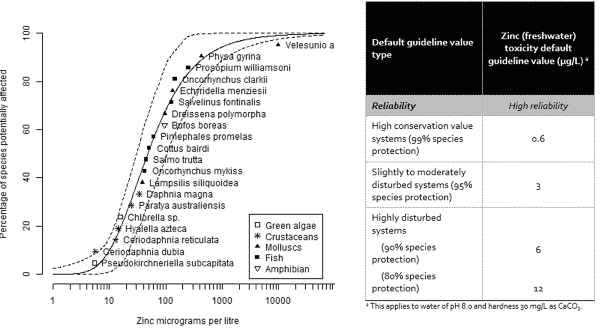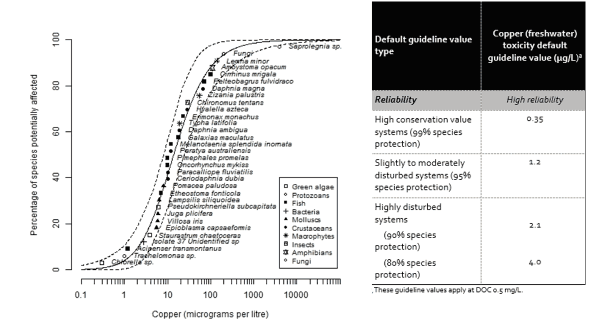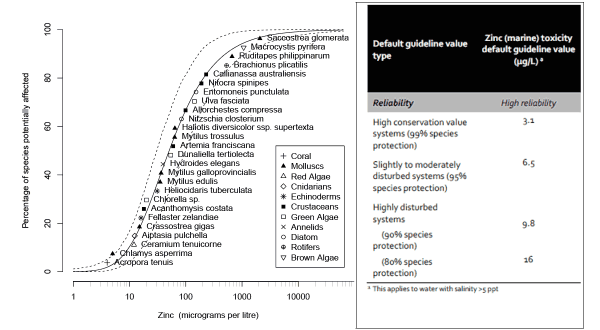The Australian and New Zealand Environment and Conservation Council (ANZECC) water quality guidelines are used extensively throughout New Zealand in managing water quality and potential effects of discharges.
The current guidelines were released in 2000 and include guidelines for the toxic contaminants copper (Cu) and zinc (Zn), in marine and freshwater, derived from laboratory toxicity studies, mainly on overseas species. New toxicity data has been reported since these guidelines were released, including data for New Zealand and Australian species. In addition, there has been substantial progress by the scientific community in understanding and modelling the influence on toxicity of water chemistry factors, such as hardness and dissolved organic carbon (DOC). The Ministry for the Environment commissioned NIWA to revise the guidelines with new data, in accordance with updated ANZECC protocols [1-3].
Guideline values (GVs) have been derived following the ANZECC protocols which provide a range of protection levels with the incorporation of water quality modifiers which affect toxicity. In many cases the default GVs are lower than the 2000 guidelines due to the inclusion of data for more sensitive species (e.g., freshwater mussels) and effects on early life stages. The updated ANZECC freshwater GVs for Cu incorporate a DOC modifier for the toxicity thresholds – with a marked reduction in toxicity with increasing DOC. Water hardness is no longer included as a water quality modifier for the chronic Cu guidelines. Freshwater Zn now includes both water hardness and pH modifiers to adjust GVs for site-specific applications. The Cu marine GVs also incorporate a DOC modifier. Simple equations are now provided to calculate site-specific GVs for differing levels of environmental protection, taking account of factors such as DOC, hardness and pH.
The review process has identified that knowledge of the sensitivity of native freshwater and marine native species is very limited. While some information is available on the acute (short-term) sensitivity of many species, particularly for metals in freshwaters (e.g., [4]), information on the chronic (long-term) sensitivity as required for the ANZECC GV derivation is lacking. For some species groups, such as our diadromous whitebait, there is a notable lack of information in the water quality conditions which would be fully protective of early life-stages and for juvenile development. Notably, some new native species information was available, such as the high sensitivity of paua (Haliotis iris) to Cu in marine waters. Incorporating this new information in the guidelines and species sensitivity distribution (SSDs) provides new insights into key species susceptibility in ecosystems affected by metal pollution inputs.
A review of monitoring on a wide range of Auckland streams in rural and urban environments has shown marked exceedance of ANZECC guidelines for both Cu and Zn—particularly in those streams affected by urban development [5]. Incorporating our improved understanding of the importance of key water quality factors affect toxicity, such as DOC concentration, into these updated guidelines identifies new potential pathways for toxicity mitigation—using targeted riparian planting of appropriate species and for improved treatment systems.
A brief summary of the species sensitivity distribution and default guidelines are provided below for Zn and Cu in fresh waters. These recommended guidelines are currently ‘draft’ and are being peer-reviewed through the ANZECC guidelines committee before they are accepted and finalised for use in NZ and Australia.
Derivation of new ANZECC water quality guidelines for copper and zinc: Supplementary material and references
Zinc – freshwater
High reliability guideline values (GVs) for zinc in freshwaters were derived from 19 chronic (long-term) toxicity data, comprising seven fish, one amphibian, five crustaceans, four molluscs and two green microalgal species. For 95% species protection, the revised default GV is 3 µg/L at a hardness of 30 mg/L and pH 8.0 (Figure 1).
The species sensitivity distribution (SSD) ranged over approximately two orders of magnitude. The lowest value in the SSD was 3.6 μg/L for the crustacean Ceriodaphnia dubia based on a 7-day reproduction test, with the next lowest value was 4.3 μg/L for the green microalgae Pseudokirchneriella subcapitata based on growth tests. The next most sensitive value was 9 mg/L, for Australian glass shrimp (Paratya australiensis) and for another green microalgae (Chlorella sp.). The least sensitive species was the the aquatic snail Physa gyrina at 161 μg/L from a 30-day mortality test [6].
Copper – freshwater
High reliability GVs for copper in freshwaters were derived from 32 chronic toxicity data, comprising nine fish, one amphibian, six crustaceans, one insect, five molluscs, three macrophytes, three green microalgal species, one bacteria, one fungi, and two protozoa. For 95% species protection, the revised default GV is 1.2 µg/L at a DOC of 0.5 mg/L (Figure 2).
The toxicity values in the SSD range over 4 orders of magnitude. The lowest value in the SSD was 0.3 mg/L, for the green algae Chlorella sp., with the next most sensitive value (1.0 mg/L) was for the protozoa Trachelomonas sp. The most sensitive animal species was the fish Acipenser transmontanus (white sturgeon) at 1.2 mg/L from 53-day growth tests on fish larvae [7].
Figure 2: Species sensitivity distribution and default guidelines for copper-freshwater (from [7])
Zinc – marine
High reliability GVs for zinc in marine waters were derived from 25 chronic toxicity data, comprising five crustaceans, two echinoderms, eight molluscs, one annelid, one rotifer, one cnidarian, one coral, two macroalgal species, three green microalgal species and two diatoms. For 95% species protection, the revised default GV is 6.5 µg/L (Figure 3).
The toxicity values in the SSD range 50-fold from lowest to highest. The lowest value was 4 μg/L, for the coral Acropora tenuis from a 5-6 day fertilisation test, with the next most sensitive value (5.0 mg/L) was for doughboy scallop (Mimachlamys asperrimus) based on larval development. The least sensitive species was the Sydney rock oyster Saccostrea glomerata with chronic toxicity value of 2080 μg/L [8].
Figure 3: Species sensitivity distribution and default guidelines for zinc-marine (from [9])
Copper – marine
High reliability GVs for copper in marine waters were derived from 57 chronic toxicity data, comprising six fish, four crustaceans, eight molluscs, two echinoderms, six corals, six bryozoa, three annelids and flatworms, six macroalgae, five microalgal species, six diatoms, and five other eukaryotic microorganisms from the Kingdom Chromista. For 95% species protection, the revised default GV is 0.6 µg/L at a DOC of 0.5 mg/L (Figure 4).
The toxicity values in the SSD range over 3 orders of magnitude. The lowest value was 0.2 μg/L, for the diatom Minutocellus polymorphus in a 3-day population growth test, with the next most sensitive values (0.3 μg/L) were for another diatom Entomoneis punctulata and for a green algae Micromonas pusilla, both in 3-day population growth tests. The most sensitive animal species was the New Zealand paua, Haliotis iris at 0.7 μg/L for 3-day larval development test. The most sensitive crustacean was the amphipod Allorchestes compressa at 3 μg/L in a 27 day population growth test. The least sensitive species was the limpet mollusc Scutus breviculus with toxicity value of 221 μg/L [8].
Figure 4: Species sensitivity distribution and default guidelines for copper-marine (from [8])
References
[1] Warne, M.S., Batley, G.E., van Dam, R.A., Chapman, J.C., Fox, D.R., Hickey, C.W., Stauber, J.L. (2015). Revised Method for Deriving Australian and New Zealand Water Quality Guideline Values for Toxicants. Prepared for the Council of Australian Government’s Standing Council on Environment and Water (SCEW) Department of Science, Information Technology, Innovation and the Arts, Brisbane, Queensland.
[2] Batley, G.E., van Dam, R.A., Warne, M.S., Chapman, J.C., Fox, D.R., Hickey, C.W., Stauber, J.L. (2014). Technical Rationale for Changes to the Method for Deriving Australian and New Zealand Water Quality Guideline Values for Toxicants. CSIRO Land and Water Report Prepared for the Council of Australian Government’s Standing Council on Environment and Water (SCEW), Sydney, Australia.
[3] Warne, M.S., Batley, G.E., Braga, O., Chapman, J.C., Fox, D.R., Hickey, C.W., Stauber, J.L., Van Dam, R. (2014). Revisions to the derivation of the Australian and New Zealand guidelines for toxicants in fresh and marine waters. Environmental Science and Pollution Research 21, 51-60.
[4] Hickey, C.W. (2000). Ecotoxicology: laboratory and field approaches. In Collier K.C., Winterbourn M., eds, New Zealand stream invertebrates: Ecology and implications for management. New Zealand Limnological Society, Christchurch, New Zealand, pp 313-343.
[5] Williamson, R.B., Mills, G.N., Hickey, C.W., Cameron, M., Vigar, N., Buckthought, L., Milne, J., Stevenson, M. (2015). Development of Copper and Zinc as Auckland Specific Attributes for Ecosystem Health: Part 1 Determining procedure and gaps. Auckland Council Technical Report, TR20xx/xxx. Prepared by Diffuse Sources Ltd for Auckland Council, Auckland.
[6] Gadd, J., Hickey, C.W. (2016). Guidelines for the protection of aquatic ecosystems, toxicant trigger values: Zinc – Freshwater. Australian and New Zealand guidelines for fresh and marine water quality. Draft September 2016. Council of Australian Governments Standing Council on Environment and Water, Canberra, ACT, Australia.
[7] Gadd, J., Hickey, C.W. (2016). Guidelines for the protection of aquatic ecosystems, toxicant trigger values: Copper – Freshwater. Australian and New Zealand guidelines for fresh and marine water quality. Draft September 2016. Council of Australian Governments Standing Council on Environment and Water, Canberra, ACT, Australia.
[8] Gadd, J., Hickey, C.W. (2016). Guidelines for the protection of aquatic ecosystems, toxicant trigger values: Copper – Marine. Australian and New Zealand guidelines for fresh and marine water quality. Draft September 2016. Council of Australian Governments Standing Council on Environment and Water, Canberra, ACT, Australia.
[9] Gadd, J., Hickey, C.W. (2016). Guidelines for the protection of aquatic ecosystems, toxicant trigger values: Zinc – Marine. Australian and New Zealand guidelines for fresh and marine water quality. Draft September 2016. Council of Australian Governments Standing Council on Environment and Water, Canberra, ACT, Australia.




